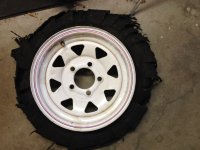I was pulling with my Chevy 2500HD Diesel that weighs about 8000lbs and when the tire went I actually thought I had hit something in the road, kinda a hard bump and a pull to the left, also allot of noise, looking in the mirror, I could see rubber flying everywhere and the vehicles in the passing lane swerving over to the left side. I never felt I had lost control of the trailer and was able safely slow down and move to the side of the interstate.
You are dead on concerning the weight, my two skis full of fuel and gear are just shy of 2,000lbs, I looked up the specifications yesterday and my trailer weighs only 500lbs so like you I am well below the tires rating so honestly I am not sure why the tire failed. Maybe I did hit something in the road or maybe the tire just failed. I checked the date and they are 6 years old not 5.
I am going to buy two new Greenball tires but still unsure if I am staying with radial or going back to bias. Have found allot of disagreement on the web concerning pro's and cons. What is the TBN consensus? Do radials have less or more sway than bias? Due to my fender height I am going to have to stay with 13" wheels and I MAY pull the trailer 2,000 miles a year.
Is your trailer aluminum Beltz ? 500# seems a bit low if not.
With a 3500# axle, many trailers will be rated for 3000# GVWR. A friend of mine who has fixed way more trailers than I ever want to has a rule of thumb - "most trailers are happy between 1/3 and 3/4 of GVWR" - heavy enough that the suspension is loaded, but not anywhere near maxed out.
I read and analyze a lot of specs, but time has also taught me the value of listening to folks who fix a lot of broken "stuff" as well....
I needed 13" tires for the old TT I picked up a couple of seasons ago - went with the Greenball Towmasters after discussions with Chris - I have been pleased with them (radial version).
Interstate speeds are the toughest on light tires, esp. down your way. I keep forgetting to take mine with me, but it would probably be a good idea to keep a cheap IR gun in your truck for checking tire temperature - once you know what normal is, you might get some idea when one tire is heading south.... Makes me wish I knew a tire engineer.... can't say I know what Max Surface Temperature is for light trailer tires....
I came across this, when I was researching my ST choices:
Tire Tech Information - Trailer Tires vs. Passenger Vehicle Tires
"
Special Trailer (ST) Tire Speed Ratings
Industry standards dictate tires with the ST designation are speed rated to 65 MPH (104 km/h) under normal inflation and load conditions.
However Goodyear Marathon and Power King Towmax STR tires featuring the ST size designation may be used at speeds between 66 and 75 mph (106 and 121 km/h) by increasing their cold inflation pressure by 10 psi (69 kPa) above the recommended pressure for the rated maximum load.
Do not exceed the wheel's maximum rated pressure. If the maximum pressure for the wheel prohibits the increase of air pressure, then maximum speed must be restricted to 65 mph (104 km/h).
The cold inflation pressure must not exceed 10 psi (69 kPa) beyond the inflation specified for the maximum load of the tire.
Increasing the inflation pressure by 10 psi (69 kPa) does not provide any additional load carrying capacity."
.
.
.
When I first came across that on Tire Rack, I don't recall them specifying brands... probably their Legal Dept. made them add that.....
My take aways from that Tirerack post:
1) ST tires are
by design marginal for Interstate use.
2) I now keep my ST tires VERY close to the Max Pressure stamped on the tire. If you are heading towards Max Load, then even 5 psi down is too low IMO.
3) If I had to do a lot of Interstate travel on ST tires at more than 2/3 load, then I would be doing more research to decide if I wanted to go with +10 PSI over.
4) Given today's legal climate, I was (and still am a bit) startled to find Tire Rack posting that recommendation online. To me, it underscores the extent of the problem with ST tires.....
Rgds, D.

